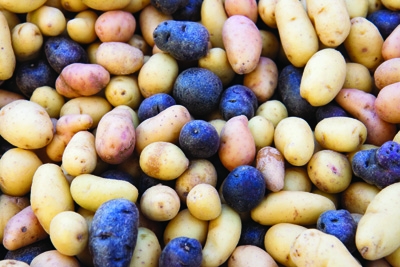
Features
Marketing
Production
Student chefs in B.C. bring new value to potato variety trials
May 4, 2012 By Tamara Leigh
 Every year, E.S. Cropconsult co-ordinates the potato variety trials, planting and evaluating 50 different varieties of potatoes.
Every year, E.S. Cropconsult co-ordinates the potato variety trials, planting and evaluating 50 different varieties of potatoes. A project in B.C. school kitchens is part of an important change in the way B.C.’s vegetable sector thinks about their products. They aren’t just helping pick the best potatoes; they are modelling the highest possibilities of a collaborative value chain.
Student chefs in four B.C. schools are taking the annual potato variety trials to the next level by evaluating them for different uses in the kitchen
The schools became involved through their participation in the Take a Bite of B.C. program, co-ordinated by B.C.
Agriculture in the Classroom. In 2010, four secondary school chef instructors attended the potato field day as part of a field trip to learn where their ingredients come from. It was the chefs who came up with the idea to provide culinary feedback on the potatoes.
Heather Meberg is president and director of grower services with E.S. Cropconsult and co-ordinates the annual potato variety trials. Now she is incorporating input from the student chefs into her analysis.
“The culinary evaluation was missing until we started working with the schools last year,” says Meberg. “First, we gather the agronomic information on developing and new varieties. Then we need to know how they perform from a culinary perspective.”
Each year Meberg and her team plant and evaluate 50 different varieties. They collect samples from the variety trials and deliver them to the four schools, where student chefs test and comment on every single variety against an industry standard using culinary and sensory analysis.
“We are getting very valuable information about the varieties we are looking at,” says Meberg. “If the agronomic performance for a potato is good but the culinary performance is poor, we’ll look at it again.”
“The students are having a ball with the program,” she adds. “Now we are progressing towards including working kitchens in the assessment process.”
Students working on the project are learning to work with different varieties, and how to choose the best potato for the job. It’s the kind of work that Martin Gooch from the George Morris Centre thinks the industry can do more of.
“The fact they are using chefs to get feedback on what varieties work, and what format, is something that traditionally we have not done in agriculture,” he says.
Gooch is director of the Value Chain Management Centre, and has recently authored a paper on adopting a value chain approach to increase the competitiveness of B.C.’s vegetable sector.
“How much development in agriculture has been done without talking to consumers? They determine value!” he says.
“If you’re in business, you are part of a value chain because ultimately you are in the business of creating value for your customer,” he adds. “The factors that will continue changing your industry are consumer driven and are not going to diminish.”
Gooch identifies five elements that are critical to value chain management:
- Focus on what consumers want and customers value. Everyone in the value chain has to keep the needs of the end-user in mind while attending to the immediate needs of their client, be that a supplier, producer, processor or retailer.
- Get the product right every time. Anything that someone produces that is not right the first time, that does not meet consumer expectation, is essentially waste.
- Ensure effective logistics and distribution. How well a value chain operates depends on how well the businesses involved are managed, and how well they interact.
- Have effective information and communication strategy among the partners of the value chain.
- Build and sustain effective relationships that sustain the value chain.
The levels of integration between the businesses in a value chain can vary widely. The development moves along a spectrum from an alliance of segmented businesses to a collaborative chain with significant interaction between partners. What changes is the level of co-operation and strategic co-ordination between partners in the chain.
“The greatest opportunity to innovate is between businesses, not within industries,” says Gooch.
While there has been a push to build closer relationships and develop value chain initiatives in B.C., the number of closely aligned chains remains relatively low. Getting there will take an attitude shift for some producers as they move toward a more customer-centred approach to business.
“Typically in agriculture we have not adopted that mindset yet,” says Gooch. “No business is an island. You are always impacted by businesses at other levels of your chain or in competing chains.”
Gooch advocates value chains as a way for the B.C. vegetable sector to reduce risk and bring down the cost of doing business. From a consumer perspective, value chains can help differentiate B.C. vegetables in the marketplace, increasing the demand for B.C. produce and the premium that consumers are willing to pay.
All of that relies on developing the best possible product for the market, and right now there is a small army of student chefs helping B.C. potato farmers hit the mark, and getting ready to take their place in the value chain.
Print this page